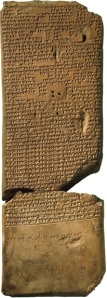The Sumerian tradition made popular in the last century revealed that the Anunnaki pantheon depicted an archetypal “Olympian” pantheon of deities that were originally assigned to twelve positions in the cosmos, later yielding the lore that would give us our “zodiac.”
 This mardukite.com blog post is excerpted from the Liber-50 material first appearing in Sumerian Religion by Joshua Free, in addition to the Sumerian Religion anthology Mesopotamian Religion and the Year-2 anthology Gates of the Necronomicon, materials also appearing in the Year-1+2 mega-anthology Necronomicon Anunnaki Legacy (Silver Edition).
This mardukite.com blog post is excerpted from the Liber-50 material first appearing in Sumerian Religion by Joshua Free, in addition to the Sumerian Religion anthology Mesopotamian Religion and the Year-2 anthology Gates of the Necronomicon, materials also appearing in the Year-1+2 mega-anthology Necronomicon Anunnaki Legacy (Silver Edition).
Prior to the Ammonite fascination with the local Sun, best observed among the Egyptians and other solar-cults, it was the more “distant” stars that were deemed the “rulers of fate” and “keepers of the
sacred cycles” that kept the organized universe in order.
The “Ancient Ones” from Sumerian prehistory (Abzu, Tiamat, Lahamu, etc.) are given mention in the literature but are viewed as more insubstantial or metaphysical essences of creation, barely able to be personified as traditional deities. We have shown in correlative chapters how such forces could be seen as the primordial essence of the All-Source being first made manifest, but the Sumerians viewed these essences as originally being made substantial in their own personal “All-Father,” a figure-head for their
hierarchical pantheon.
 The position of Anu in the Sumerian pantheon is as an undisputed “father in heaven,” who acts as the supreme “progenitor” or “father of the gods” from his place as the “king of the local universe.” The “House of Anu” (the traditional “heaven” or “abode of the gods”) is sometimes written as UR.ANU or “Uranus” (from the Greek “Ouranos”) and his most sacred place of “worship” on earth was in Uruk at the temple of E.ANNA – also translated to mean “House of Anu.” The number of his rank is sixty – the number of cosmic perfection.
The position of Anu in the Sumerian pantheon is as an undisputed “father in heaven,” who acts as the supreme “progenitor” or “father of the gods” from his place as the “king of the local universe.” The “House of Anu” (the traditional “heaven” or “abode of the gods”) is sometimes written as UR.ANU or “Uranus” (from the Greek “Ouranos”) and his most sacred place of “worship” on earth was in Uruk at the temple of E.ANNA – also translated to mean “House of Anu.” The number of his rank is sixty – the number of cosmic perfection.
Mesopotamian traditions came to view Anu in a similar manner as the abstract Babylonian expression of Ilu, where he became the “Lofty One” or “Supreme God Most High” in the pantheon, a remote, distant and indiscriminate All-Father much more representative of the “Heavenly Father” that Jesus alluded to in the New Testament then that of the Old Testament God of the Hebrew. The solidity of his personification becomes increasingly faint in descending traditions, and though within his power, he rarely intervenes or makes an appearance to the “earth” world of gods and men. His main function in the pantheon is as the “Father” of the gods, who are then mainly left to deal with material universe on their own accord.
 Few of the incantation tablets (or “prayers”) invoke the powers of Anu directly. The heavenly force is perceived as too vast to be channeled directly by the successors and to degrade it to anything more accessible would be to compromise the nature of what is represented.
Few of the incantation tablets (or “prayers”) invoke the powers of Anu directly. The heavenly force is perceived as too vast to be channeled directly by the successors and to degrade it to anything more accessible would be to compromise the nature of what is represented.
In the Semitic traditions the role of Kingship in Heaven is equated to the full extent of power that keeps the universe in motion, contained in an “unspeakable” and “unknowable” name (termed the “Tetragrammaton” in the modern Hebrew-based mysticism).
It is more common for the Sumerian magician or priest to evoke a subsidiary deity from the pantheon (lineage) to invoke the names known to them rather than pursue methods of Egypto-Hermetic cryptomancy to divine and compel spirits against their will using “true-names.” In the Chaldeo-Babylonian tradition, the names of Enki and Marduk are evoked to speak the names (and later deriving traditions often used them to replace obscure and “secret” names altogether).
“True indeed there was a supreme name which possessed the power of commanding the gods and extracting from them a perfect obedience, but that name remained the inviolable secret of Hea [EA – Enki]. In exceptionally grave cases he [the enchanter] besought Hea, through the mediator Silikmulukhi [Marduk], to pronounce the solemn word in order to re-establish order in the world and restrain [temper] the powers of the abyss. But the enchanter did not know that name, and could not in consequence introduce it into his formulae… he could not obtain or make use of it, he only requested the god who knew it to employ it, without endeavoring to penetrate the terrible secret himself.”
–M. Lenormant, Chaldean Magic & Sorcery, 1874










Pingback: New Babylon Rising – The Anunnaki & Necronomicon Magick, Sixth Anniversary Summer Solstice Issue | BABYLON 3.0 - A Brave New Babylonian Rising